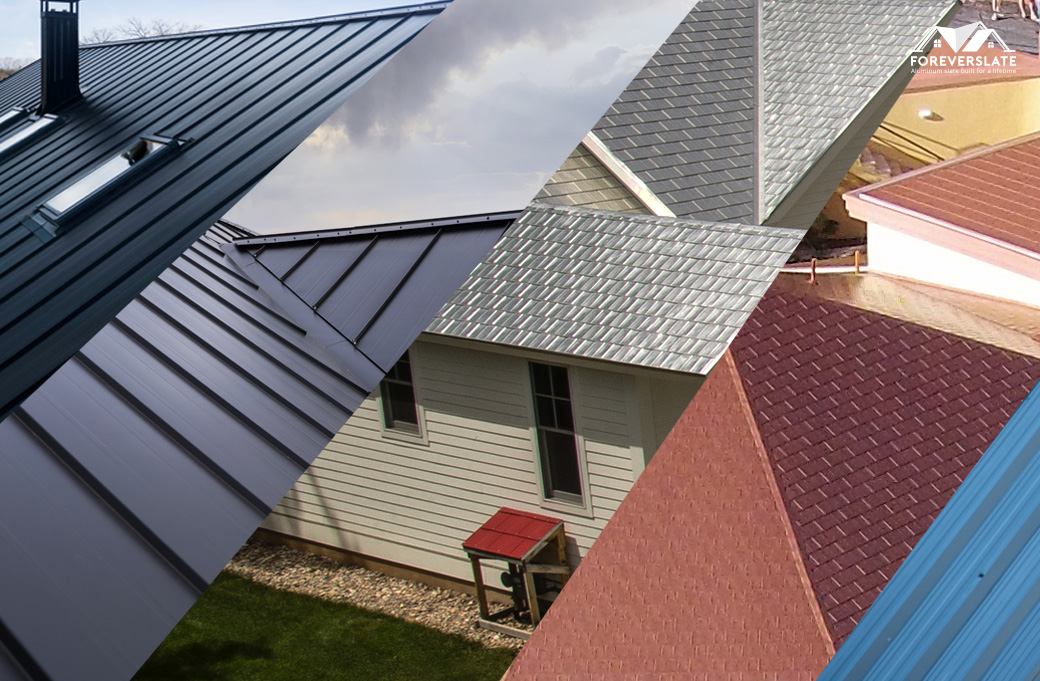Published On February 16 , 2023

Whether you’re in the market for a new metal roof, a distributor looking to sell metal products, or a contractor working with a homeowner or business owner, it’s crucial to understand the pros and cons of different metal roofing materials.
The top 5 most commonly used metal roofing are Galvalume, aluminum, zinc, copper, and stainless steel. In this blog, we will go through each material, its unique benefits and drawbacks, and why it’s essential to discuss them thoroughly with the contractor, distributor, architect, or manufacturer before making a final choice

This metal roofing material is made from a combination of three high-performance coatings – steel, aluminum, and zinc. Galvalume starts with a cold-rolled carbon steel base sheet, which is then coated with a mixture of 55% aluminum, 43.4% zinc, and 1.6% silicone through a hot-dipping process. This unique composition gives Galvalume the best qualities of each metal, making it a top choice for metal roofing.
Cheaper Price
Corrosion Resistant
Easy To Handle & Install
Warranties
Oil Canning
Not Suitable For Animal Enclosures Or Buildings
Interactions With Other Materials

Aluminum is a lightweight, silvery-white metal that is found in element number 13 on the periodic table. It is one of the most abundant elements on the planet but is never found in its pure metallic form in nature. Instead, it is extracted from its compounds, primarily aluminum sulfates, through a process of electrolysis or electrolytic reduction.
In terms of building materials, aluminum is highly versatile and can be used for roofing, wall cladding, trim, and other applications in a variety of environments, including coastal areas, regions with high rainfall or snowfall, hurricane-prone zones, and areas with high temperatures.
Suitable For Use In Coastal Environments
Warrantied Product
Self-Healing & No Red Rust
Lightweight & Strong
Highly Recyclable
Medium-High Price Point
Denting Concerns
Requires More Space For Thermal Movement
Natural Color

Zinc is a shiny metal with a bluish-white color and is found in abundance on Earth, being the 24th most abundant element in the Earth’s crust. According to geogly.com, zinc is currently one of the four most consumed metals globally, after iron, aluminum, and copper.
Zinc is a material that is gaining popularity in the standing seam metal roofing industry in the United States and is relatively common in Europe. It is known for its durability against weather elements, its self-healing properties, and its environmentally friendly nature.
Longevity
Eco-friendly
Self-Healing Characteristics
Easy To Form
Limited Warranty Options
Expensive
Underside Corrosion
Ventilation Concerns
Expansion And Contraction Concerns
Limited Engineering Options

Copper is a highly malleable and ductile metal with exceptional thermal and electrical conductivity. Its distinctive reddish-orange color has been used in roofing for centuries, dating back to the roof of the Pantheon in 27 B.C., as recorded in historical records.
Nowadays, copper roofing continues to be a popular choice for architectural projects, commercial buildings, and even residential homes due to its attractive appearance. Many property owners incorporate copper as an attractive accent piece on their roof or in features such as cupolas, chimney caps, awnings, and more.
Lightweight
Durability
Aesthetically Pleasing
Highly Recyclable
Solderable
Limited Warranty Options
Very Expensive
Expansion And Contraction Concerns
Unpredictable Patina
Run-Off Staining
Dissimilar Metals Issues
Limited Engineering Options

Stainless steel is a type of iron alloy that contains at least 10.5% chromium, along with other elements such as carbon and metals to enhance its properties.
When we think of stainless steel, our minds often conjure images of large architectural structures like elevators, bridges, building columns, handrails, and more. However, stainless steel is also widely used in the kitchen for appliances, cutlery, cookware, and more.
In the metal roofing industry, stainless steel is a highly prized material due to its strength and durability. This high-end specialty metal may be the ideal choice for certain projects, offering both durability and strength.
Durability
Weathers Elements
Variety Of Finish Options
Other Uses (Indoors)
No Substrate Warranty
Expensive
Expansion And Contraction Concerns
Not Recommended Where There Is Standing Water
When choosing a metal roofing material, it’s important to consider the specific characteristics of your residential or commercial structure. This will help you determine which of the following materials – Galvalume, aluminum, zinc, copper, or stainless steel – will be the best solution for your needs.
Once you have an understanding of your structure, consider the following factors to determine the best material for your roofing project:
Cost: Consider your budget when making your decision.
Material Strength: The climate, UV exposure, weathering, snow, rainfall, and other factors should be considered when determining the strength of the material.
Structure’s Weight Capacity: Choose a material that your structure can withstand.
Sustainability: Consider the environmental impact of the material you choose.
Energy Efficiency: Look for materials that are energy-efficient and recyclable.
Maintenance: Choose a material that requires minimal maintenance.
Compatibility: Consider the compatibility of the roofing material with other materials your roof or water run-off will come in contact with.
Availability: Make sure the material you choose is readily available.